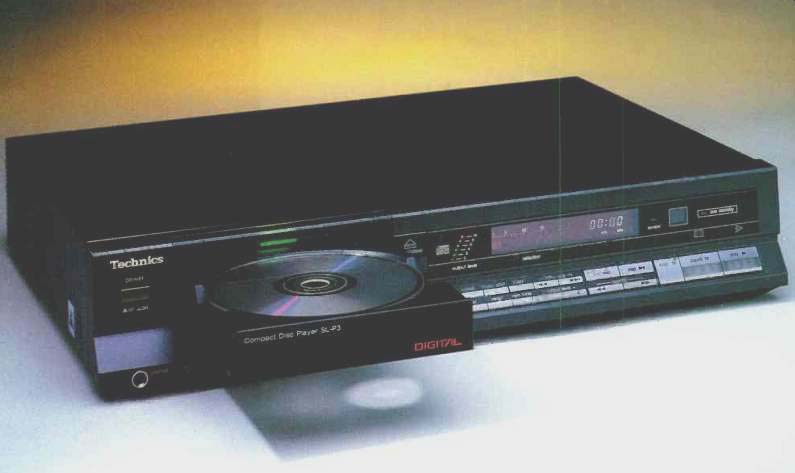
Manufacturer's Specifications:
Frequency Response: 4 Hz to 20 kHz, ±0.5 dB
Dynamic Range: Greater than 96 dB.
S/N Ratio: Greater than 96 dB.
THD: Less than 0.003% at 1 kHz, 0-dB recorded level.
Channel Separation: Greater than 90 dB.
Number of Programmable Selections: 15.
Output Level: 2.0 V for 0-dB recorded level.
Headphone Output Level: 80 mW into 32-ohm load, adjustable.
Power Consumption: 33 watts.
Dimensions: 16-15/16 in. W x 3 1/4 in. H x 13 1/8 in. D (43 cm x 8.2 cm x 33.4 cm).
Weight: 11.7 lbs. (5.3 kg).
Price: $600.
Company Address: One Panasonic Way, Secaucus, N.J. 07094.
More and more companies are now offering third-generation CD players. One of the more recent introductions is Technics' SL-P3, the top model in a group of three totally redesigned units from that company. From the looks of it, the designers sought to incorporate just about every convenience feature imaginable, having now had three years in which to survey the needs of consumers and the features that were available in first- and second-generation Compact Disc players.
Besides a 15-step, random-access programming capability, the SL-P3 offers a multi-function wireless remote control, expanded repeat functions, automatic pause, automatic cueing and an output level control with an associated LED level indicator. The wireless remote-control unit is able to perform the random-access programming functions, and even to adjust volume.
Another new and unusual feature on the SL-P3 is the "Disc Prism." Found on the motor-driven loading drawer, this prism arrangement reflects the image of the spinning CD forward. You can therefore see that a disc has been loaded into the player while you view the front panel, even though the disc is actually oriented horizontally. I suspect that this novel arrangement (including illumination of the prism for easier viewing) was developed to counter the uneasiness of some consumers over the fact that their discs "disappear" inside their CD players, and their doubts about whether the disc will ever be recovered. (Of course, these nightmares are unlikely to happen in reality.)
Control Layout
Major operating controls of the SL-P3 are larger and more easily accessed than the less often-used switches. The lower part of the player's front panel is slanted toward the user, so all control keys can be seen and operated easily.
Ten numbered keys and a memory key, positioned on this section of the panel, are used to perform the 15-selection, random-access programming. You can choose which tracks you want to hear in whatever order you prefer; direct access by track numbers can also be performed using these keys, as can programming and direct access by index numbers. (Index numbers are now found on an in creasing number of CDs; they subdivide longer tracks, such as movements of a symphony, into recognizable parts musical themes, for example. For those who want to quickly access a specific theme within a movement, index numbers provide the means.)
The "Repeat" button lets you listen to the entire disc, or programmed shorter sections of the disc, over and over again. The "A-B Repeat" button permits instant replay of any specified section selected during the playing of a disc.
Automatic "Music Scan" lets you preview the first few seconds of each track in a disc; the number of seconds can be adjusted by using the numbered front-panel keys, from 1 to 99 S. Sliding a switch, at the lower left of the front panel, to the "Auto Pause" position causes the laser pickup to pause at the beginning of each track. Moving this switch to "Auto Cue" makes the SL-P3 stand by at the beginning of each selection for instant starts at the touch of a button. With auto cueing engaged, the system seeks out the first note on each track and activates a "Cue Standby" indicator when ready.
The auto cueing function differs from "Auto Pause," since there may be a few seconds of time between the start of a given track and the actual start of music on that track. The auto-cue feature will be especially welcomed by disc jockeys who use this machine for broadcast, since it will permit more accurate cueing than is possible by simply specifying a track number.
Up/down output level buttons that control volume electronically are also provided on the front panel, while a "Rem Time" key displays the total time remaining on a disc during play whenever it is pressed. The larger, more basic keys include "Play," "Stop," "Search" (bidirectional) and "Pause." The "Search" keys operate at high and low speeds, and let you hear sounds at normal pitch. "Skip" keys move the laser pickup forward or backward over any number of tracks, depending upon the number of times the key is pushed.
The large, fluorescent display includes a 15-bar horizontal graph which indicates which track is playing by blinking the bar corresponding to that track. The display also shows track number and index number, as well as total playing time and remaining play time in minutes and seconds.
Indicators are also provided for the repeat function, A-B repeat, music scan, 15-track overrun (in the event that a given disc contains more than 15 tracks), and disc compartment status. The Technics SL-P3 is also equipped with a headphone jack with its own separate volume control, and an automatic-timer play mode.
Measurements
Frequency response for this CD player, plotted in Fig. 1 for both the left and right channels, was flat within 0.2 dB over the entire audio range, from 20 Hz to 20 kHz. Harmonic distortion at maximum recorded level varied from 0.0035% to 0.007%, depending upon the test frequency used. Figure 2 shows how THD varies with both frequency and reference recorded level. Notice that I did not plot THD above 10 kHz.
At high frequencies, my distortion analyzer began to read unusually high numbers which I suspected were not really harmonic distortion. Spectrum analysis revealed that these higher readings were, in fact, super-audible "beats" outside the audio spectrum, and Fig. 3 illustrates this. The range of sweep in this photo is from 0 Hz to 50 kHz, in linear increments of 5 kHz per horizontal division. The tall spike in the display represents a desired 20-kHz signal, while the shorter spike, immediately to its right, is a signal at a frequency of approximately 24.1 kHz. It is only about 45 to 46 dB lower than the desired signal, which explains why the distortion analyzer read nearly 0.5%. Despite the high meter reading of my distortion analyzer, the presence of this ultra sonic beat frequency did not interfere with the sound quality of the player.
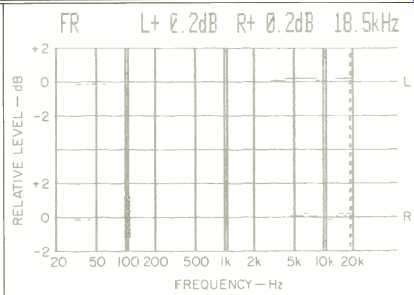
Fig. 1-Frequency response, left (top) and right channels.
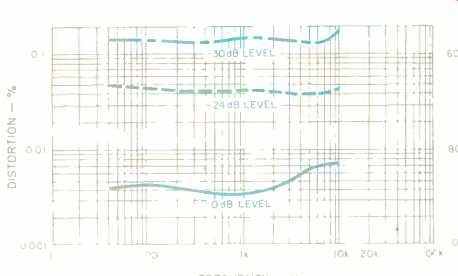
Fig. 2-THD vs. frequency at three output levels.
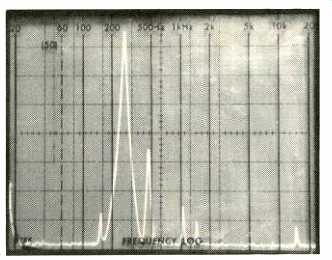
Fig. 3-Spectrum analysis of 20-kHz signal (large spike) shows inaudible
beat tone at 24.1 kHz, about 45 dB lower than the desired output.
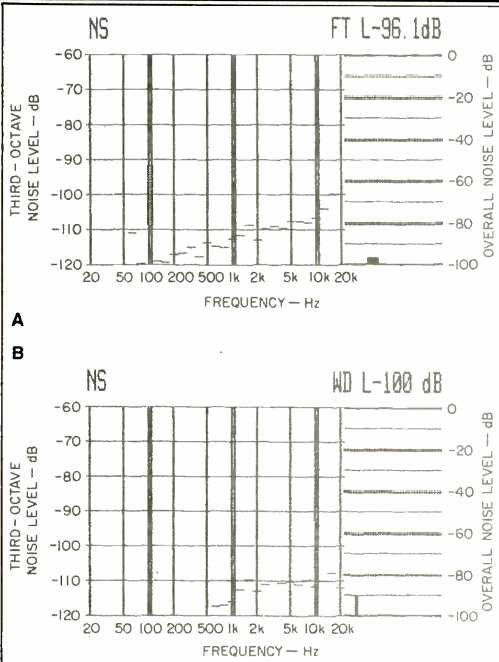
Fig. 4-S/N analysis, both unweighted (A) and A-weighted (B).
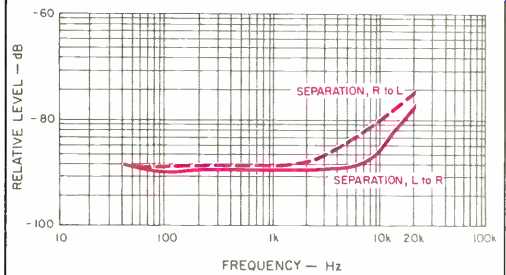
Fig. 5-Separation vs. frequency.
Unweighted signal-to-noise ratio measured just over 96 dB; residual noise of the player is analyzed in the graph of Fig. 4A. When an A-weighting network was added to the measurement setup, the signal-to-noise ratio was even higher-100.0 dB exactly, as shown in Fig. 4B. IM distortion at maximum recorded level was only 0.0075%, increasing to a still inaudible 0.017% at-20 dB recorded level. Output linearity was accurate to within 0.5 dB down to-80 dB.
Maximum output level was exactly 2.0 V, but, of course, if the player's variable output level control is used, this can be adjusted to suit the needs of any amplifier and to conform with other program sources which the user's audio system may include.
Stereo separation was about what I have come to expect from CD players, ranging from over 75 dB at the high-frequency extremes to nearly 90 dB. A plot of separation versus frequency for both left-to-right and right-to-left channel crosstalk is shown in Fig. 5.
Figures 6 and 7 clearly demonstrate that Technics has chosen to stay with multi-pole, analog output filters. The 1-kHz square wave shown in Fig. 6 exhibits the type of ringing normally associated with such output filters, as does the overhang or ringing seen in the reproduced unit-pulse test signal shown in Fig. 7.
Despite the use of a steep filter, however, the relationship between the 200-Hz signal on the left channel and the 2-kHz signal on the right, reproduced in the 'scope photo of Fig. 8, shows no evidence of any phase shift or phase delay at the higher of the two frequencies.
Since most CD players offer superlative sound quality, assessment of tracking and error-correction ability is one of the important ways to judge differences between models.
One of the more noteworthy improvements I've been finding on second- and third-generation players is their ability to handle severe dropouts and other disc defects. In these areas, the SL-P3 won high marks, playing through my "obstacle course" disc-the one with the built-in defects and opaque sections-as if the disc were perfect. The player also resisted mistracking when subjected to moderate external vibration or shock.
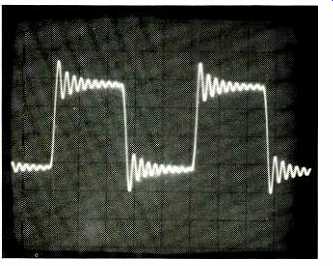
Fig. 6--Reproduction of 1-kHz square wave.
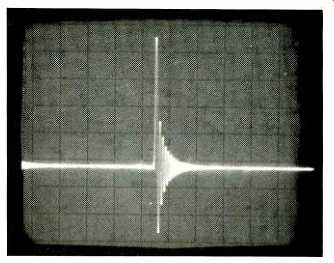
Fig. 7--Single-pulse test.
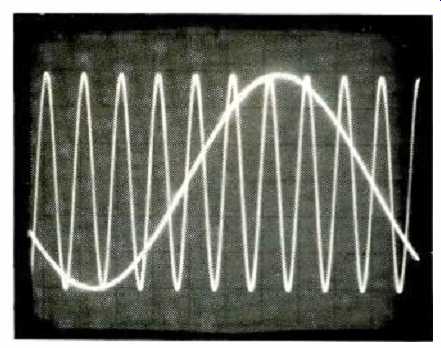
Fig. 8--Phase-error test using tones of 200 Hz (left channel) and 2 kHz
(right channel).
Use and Listening Tests
I found the Technics SL-P3 extremely easy to use and easy to program, despite its rather elaborate programming functions. Controls are logically arranged, and logically and intelligently identified. The lightweight, hand-held wireless remote control performs just about every function you would want to direct from across a room, short of opening the disc drawer itself.
Sound quality was as good as I have come to expect from a well-engineered player. Evidently there's more to making a CD player sound good than simply going to oversampling or to digital filtering (both of which Technics chose not to do in this model). Depth and breadth of stereo imaging was very good, and only some of my older discs exhibited the high-frequency graininess that has been attributed to CDs and CD players in general. Some more recently acquired CDs sounded just fine, and I found that the speed of access, characteristic of the third-generation players, was about 1 S between any two points on the disc.
Perhaps the thing that impressed me most about this new Technics model was not so much its excellent sound quality (I've come to expect that from all late-model players) but rather the number of useful features available. Barely two years ago, a player having all these features, if available at all, would have easily cost twice as much as this one does.
-Leonard Feldman
(adapted from: Audio magazine, Aug. 1985)
Also see:
Technics SL-P8 Compact Disc Player (April 1984)
Technics SL-P1200 Compact Disc Player (Dec. 1987)
Technics SA-GX910 A/V Receiver (July 1992)
= = = =